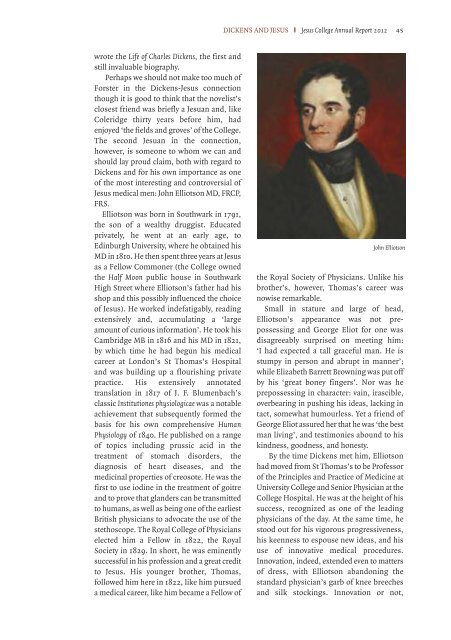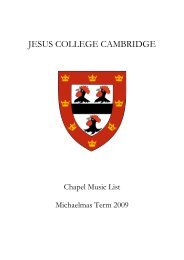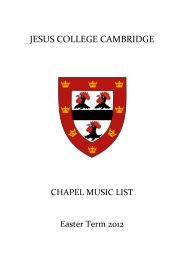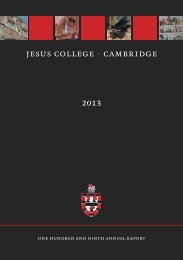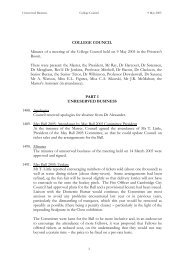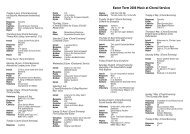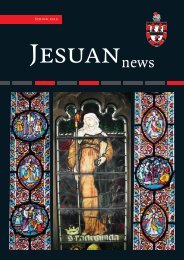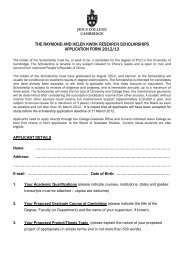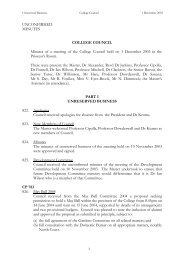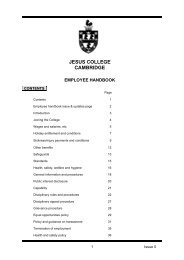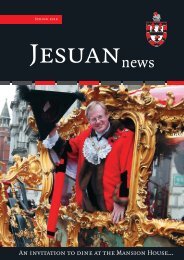2012 Annual Report - Jesus College - University of Cambridge
2012 Annual Report - Jesus College - University of Cambridge
2012 Annual Report - Jesus College - University of Cambridge
You also want an ePaper? Increase the reach of your titles
YUMPU automatically turns print PDFs into web optimized ePapers that Google loves.
wrote the Life <strong>of</strong> Charles Dickens, the first and<br />
still invaluable biography.<br />
Perhaps we should not make too much <strong>of</strong><br />
Forster in the Dickens-<strong>Jesus</strong> connection<br />
though it is good to think that the novelist’s<br />
closest friend was briefly a Jesuan and, like<br />
Coleridge thirty years before him, had<br />
enjoyed ‘the fields and groves’ <strong>of</strong> the <strong>College</strong>.<br />
The second Jesuan in the connection,<br />
however, is someone to whom we can and<br />
should lay proud claim, both with regard to<br />
Dickens and for his own importance as one<br />
<strong>of</strong> the most interesting and controversial <strong>of</strong><br />
<strong>Jesus</strong> medical men: John Elliotson MD, FRCP,<br />
FRS.<br />
Elliotson was born in Southwark in 1791,<br />
the son <strong>of</strong> a wealthy druggist. Educated<br />
privately, he went at an early age, to<br />
Edinburgh <strong>University</strong>, where he obtained his<br />
MD in 1810. He then spent three years at <strong>Jesus</strong><br />
as a Fellow Commoner (the <strong>College</strong> owned<br />
the Half Moon public house in Southwark<br />
High Street where Elliotson’s father had his<br />
shop and this possibly influenced the choice<br />
<strong>of</strong> <strong>Jesus</strong>). He worked indefatigably, reading<br />
extensively and, accumulating a ‘large<br />
amount <strong>of</strong> curious information’. He took his<br />
<strong>Cambridge</strong> MB in 1816 and his MD in 1821,<br />
by which time he had begun his medical<br />
career at London’s St Thomas’s Hospital<br />
and was building up a flourishing private<br />
practice. His extensively annotated<br />
translation in 1817 <strong>of</strong> J. F. Blumenbach’s<br />
classic Institutiones physiologicae was a notable<br />
achievement that subsequently formed the<br />
basis for his own comprehensive Human<br />
Physiology <strong>of</strong> 1840. He published on a range<br />
<strong>of</strong> topics including prussic acid in the<br />
treatment <strong>of</strong> stomach disorders, the<br />
diagnosis <strong>of</strong> heart diseases, and the<br />
medicinal properties <strong>of</strong> creosote. He was the<br />
first to use iodine in the treatment <strong>of</strong> goitre<br />
and to prove that glanders can be transmitted<br />
to humans, as well as being one <strong>of</strong> the earliest<br />
British physicians to advocate the use <strong>of</strong> the<br />
stethoscope. The Royal <strong>College</strong> <strong>of</strong> Physicians<br />
elected him a Fellow in 1822, the Royal<br />
Society in 1829. In short, he was eminently<br />
successful in his pr<strong>of</strong>ession and a great credit<br />
to <strong>Jesus</strong>. His younger brother, Thomas,<br />
followed him here in 1822, like him pursued<br />
a medical career, like him became a Fellow <strong>of</strong><br />
DICKENS AND JESUS I <strong>Jesus</strong> <strong>College</strong> <strong>Annual</strong> <strong>Report</strong> <strong>2012</strong> 45<br />
John Elliotson<br />
the Royal Society <strong>of</strong> Physicians. Unlike his<br />
brother’s, however, Thomas’s career was<br />
nowise remarkable.<br />
Small in stature and large <strong>of</strong> head,<br />
Elliotson’s appearance was not prepossessing<br />
and George Eliot for one was<br />
disagreeably surprised on meeting him:<br />
‘I had expected a tall graceful man. He is<br />
stumpy in person and abrupt in manner’;<br />
while Elizabeth Barrett Browning was put <strong>of</strong>f<br />
by his ‘great boney fingers’. Nor was he<br />
prepossessing in character: vain, irascible,<br />
overbearing in pushing his ideas, lacking in<br />
tact, somewhat humourless. Yet a friend <strong>of</strong><br />
George Eliot assured her that he was ‘the best<br />
man living’, and testimonies abound to his<br />
kindness, goodness, and honesty.<br />
By the time Dickens met him, Elliotson<br />
had moved from St Thomas’s to be Pr<strong>of</strong>essor<br />
<strong>of</strong> the Principles and Practice <strong>of</strong> Medicine at<br />
<strong>University</strong> <strong>College</strong> and Senior Physician at the<br />
<strong>College</strong> Hospital. He was at the height <strong>of</strong> his<br />
success, recognized as one <strong>of</strong> the leading<br />
physicians <strong>of</strong> the day. At the same time, he<br />
stood out for his vigorous progressiveness,<br />
his keenness to espouse new ideas, and his<br />
use <strong>of</strong> innovative medical procedures.<br />
Innovation, indeed, extended even to matters<br />
<strong>of</strong> dress, with Elliotson abandoning the<br />
standard physician’s garb <strong>of</strong> knee breeches<br />
and silk stockings. Innovation or not,


